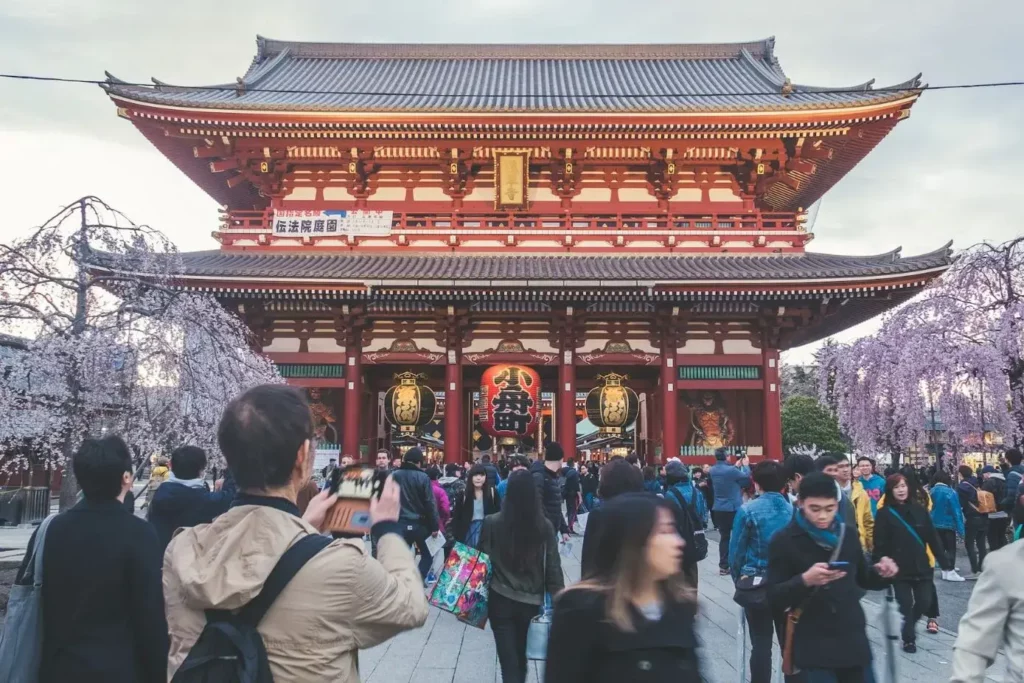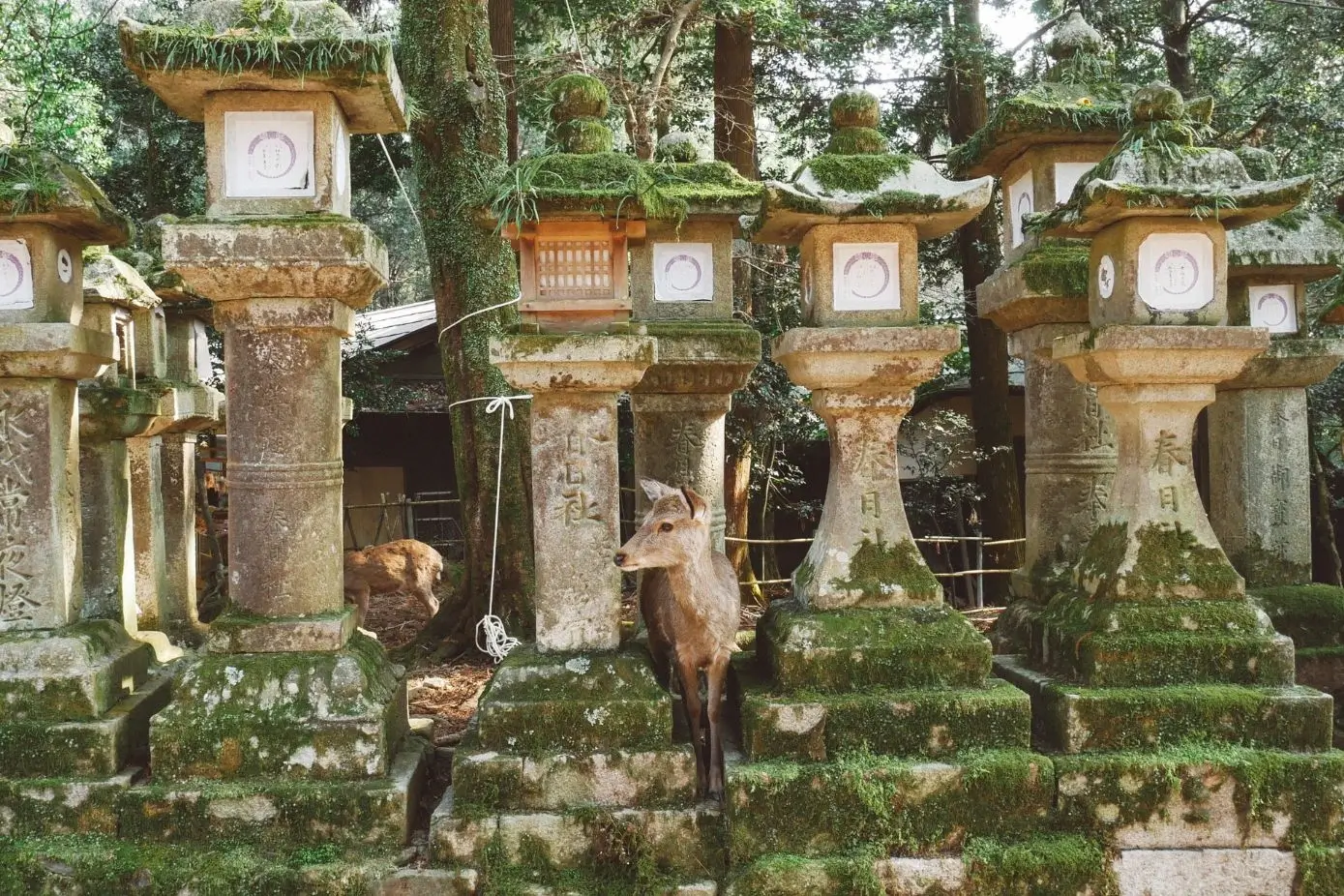Nestled in the heart of Tokyo, Asakusa stands as a testament to Japan’s rich history, effortlessly merging its ancient roots with the pulsating energy of urban life.
As you stroll its streets, you’ll discover a tapestry woven from tradition and modernity. This iconic neighborhood, once the cultural and entertainment hub of Tokyo, still resonates with echoes of its storied past.
Today, it beckons visitors with a blend of time-honored landmarks and contemporary attractions.
Whether you’re seeking spiritual solace at a centuries-old temple or looking to ascend modern architectural marvels for panoramic views, Asakusa promises a captivating experience.
Let’s embark on a journey through its charming alleys and discover the 20 best things to do in Asakusa.
Best Things to Do in Asakusa
- Senso-ji Temple
- Nakamise Shopping Street
- Sumida River Cruise
- Tokyo Skytree
- Asakusa Culture and Tourist Information Center
- Rickshaw Ride
- Hanayashiki Amusement Park
- Kappabashi Kitchen Street
- Asakusa Engei Hall
- Sumida Aquarium
- Hoppy Street
- Taste Ningyo-yaki
- Azumabashi Bridge
- Sanja Matsuri
- Edo Shitamachi Traditional Crafts Museum
- Asakusa Public Hall
- Sumida Park
- Demboin Garden
- Try Traditional Sweets at Funabashiya
- Rokku Entertainment District
Senso-ji Temple
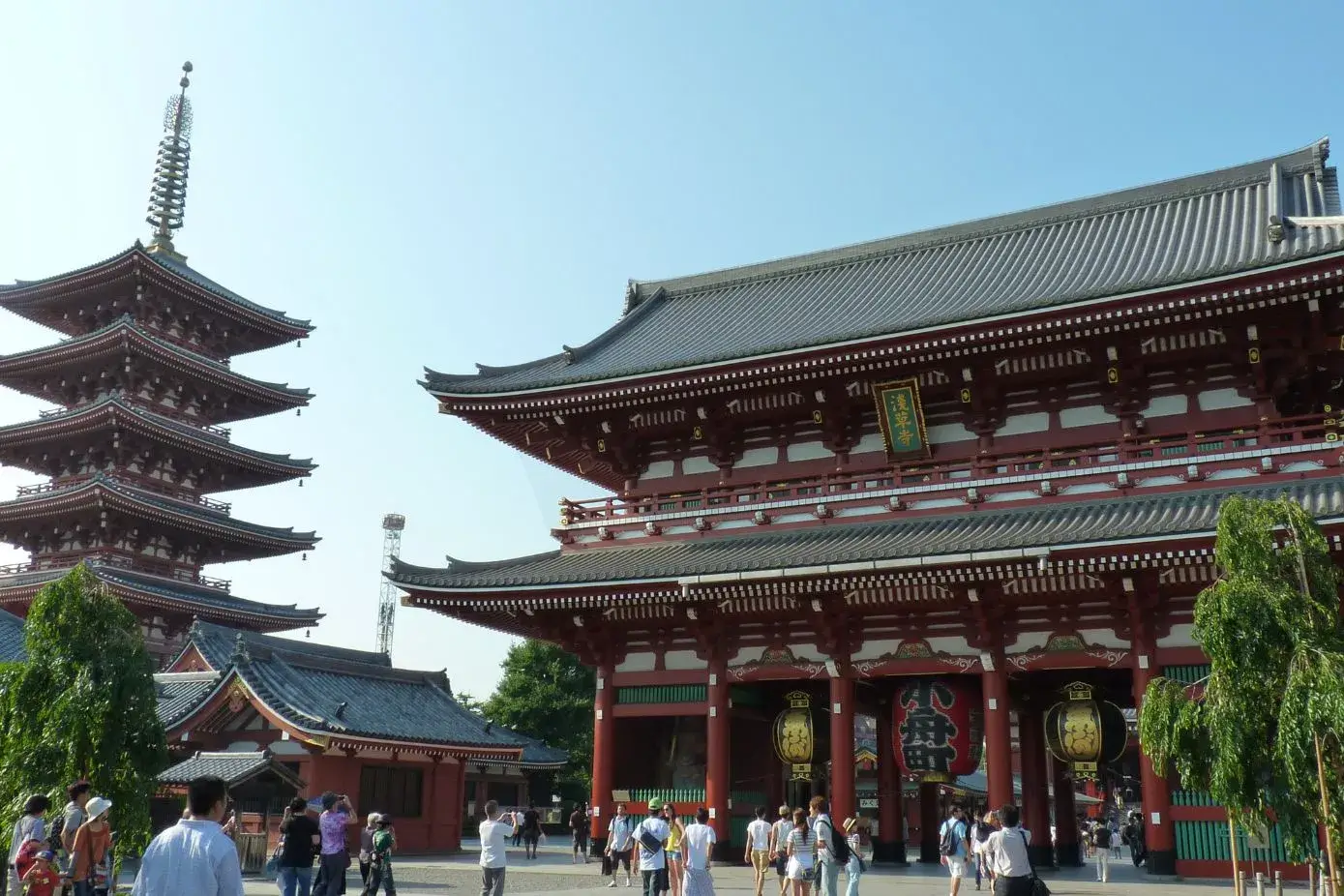
Diving straight into Asakusa’s historic heart, the Senso-ji Temple immediately commands attention.
Established in the 7th century, it proudly wears the title of Tokyo’s oldest temple. As you approach, the majestic Thunder Gate, or Kaminarimon, greets you with its imposing structure, crowned by a colossal red lantern.
Stepping through this gateway, a sense of tranquility washes over visitors, juxtaposed against the surrounding urban hustle.
Delving deeper, the temple grounds unfold a rich tapestry of history and architecture. Strolling further, you’ll notice intricately designed pagodas and halls, each telling tales of bygone eras.
And while the main hall draws worshippers with its spiritual ambiance, the wafting incense and melodious chants truly transport you to a realm of reverence.
Before departing, many visitors also take a moment to draw their omikuji, or fortune slips, hoping for blessings and good luck.
Nakamise Shopping Street
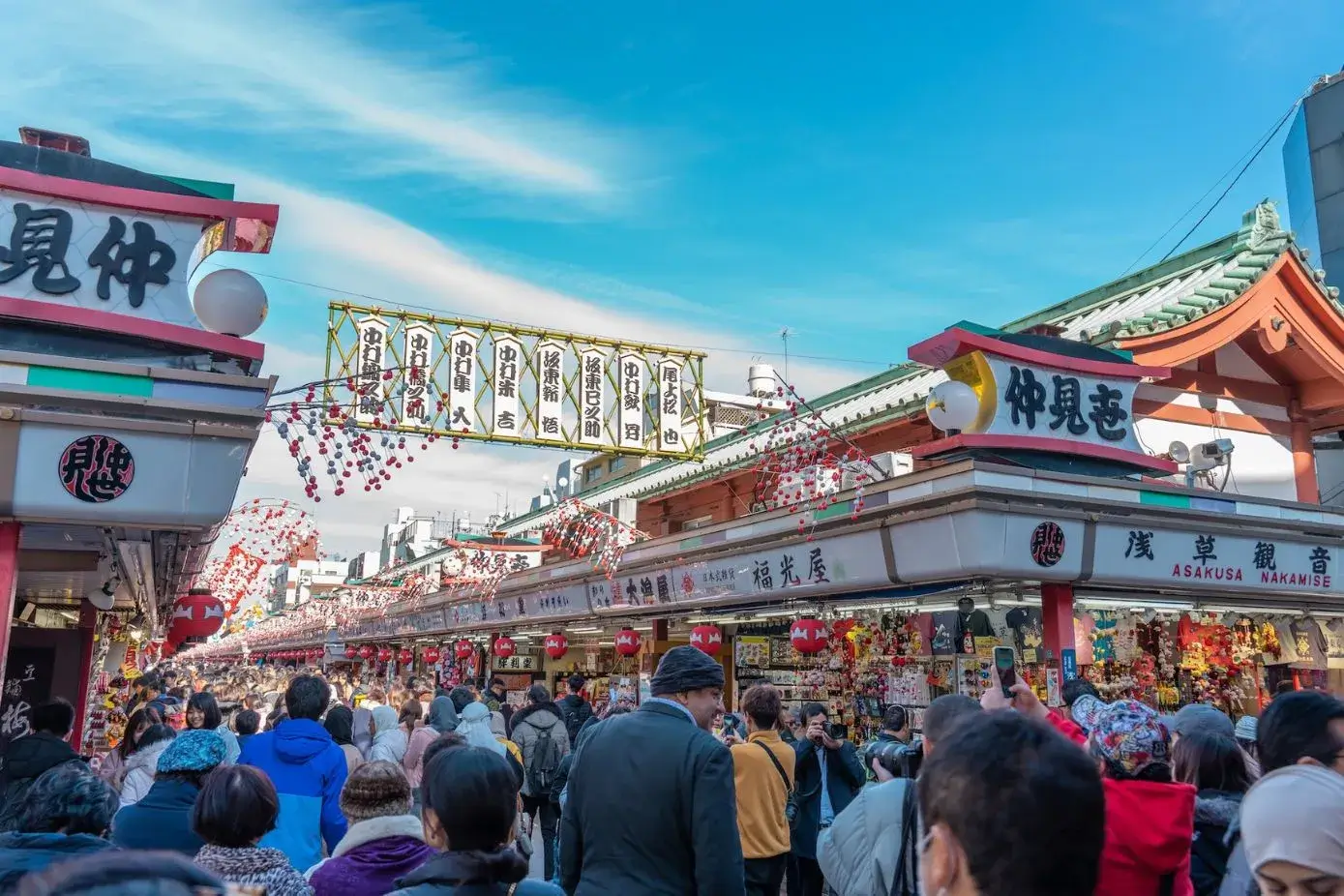
Just a stone’s throw from Senso-ji Temple, the Nakamise Shopping Street invites visitors into a vibrant world of tradition.
Stretching over 250 meters, this bustling lane is a sensory delight. As you walk, stalls brimming with handcrafted souvenirs, local snacks, and traditional wear line the path.
Each step offers a glimpse into Asakusa’s cultural tapestry, from the enticing aroma of fresh ningyo-yaki to the artisan’s careful craft of wooden trinkets.
While some modern goods have found their way into this historic marketplace, the essence of old Tokyo endures.
Sumida River Cruise
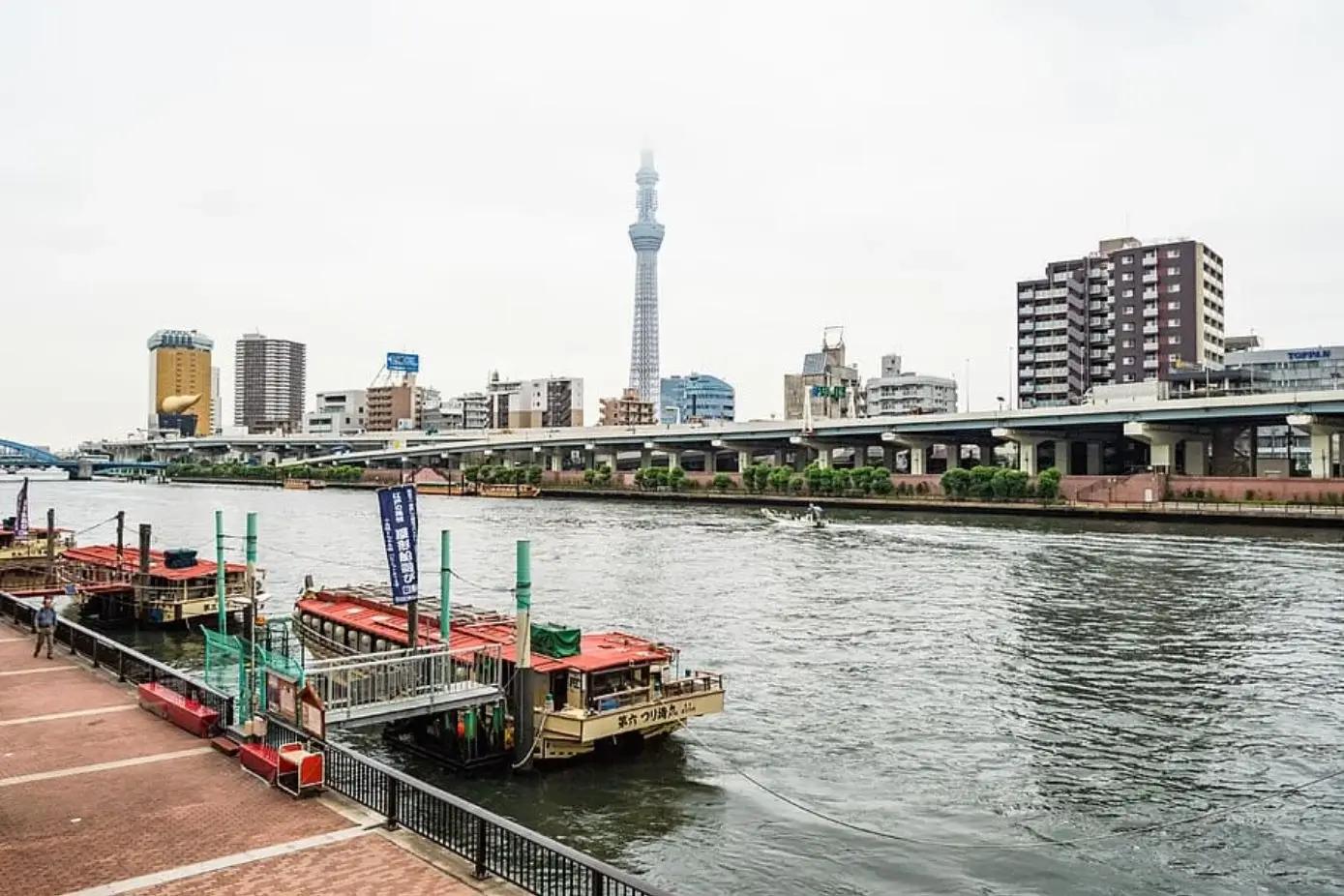
Setting your sights beyond Asakusa’s bustling streets, the Sumida River offers a refreshing perspective.
Embarking on a Sumida River Cruise, you’re immediately treated to panoramic views of Tokyo’s skyline.
As the boat glides effortlessly on the water, iconic landmarks, from age-old temples to soaring skyscrapers, parade before your eyes.
Each bend of the river reveals a new vista, painting a vivid picture of Tokyo’s blend of history and modernity.
The gentle sway of the cruise combined with the city’s reflections dancing on the water surface creates an enchanting experience.
For those seeking a touch of tradition, some cruises operate on ‘yakatabune’ boats, featuring tatami seating and an old-world charm.
Tokyo Skytree
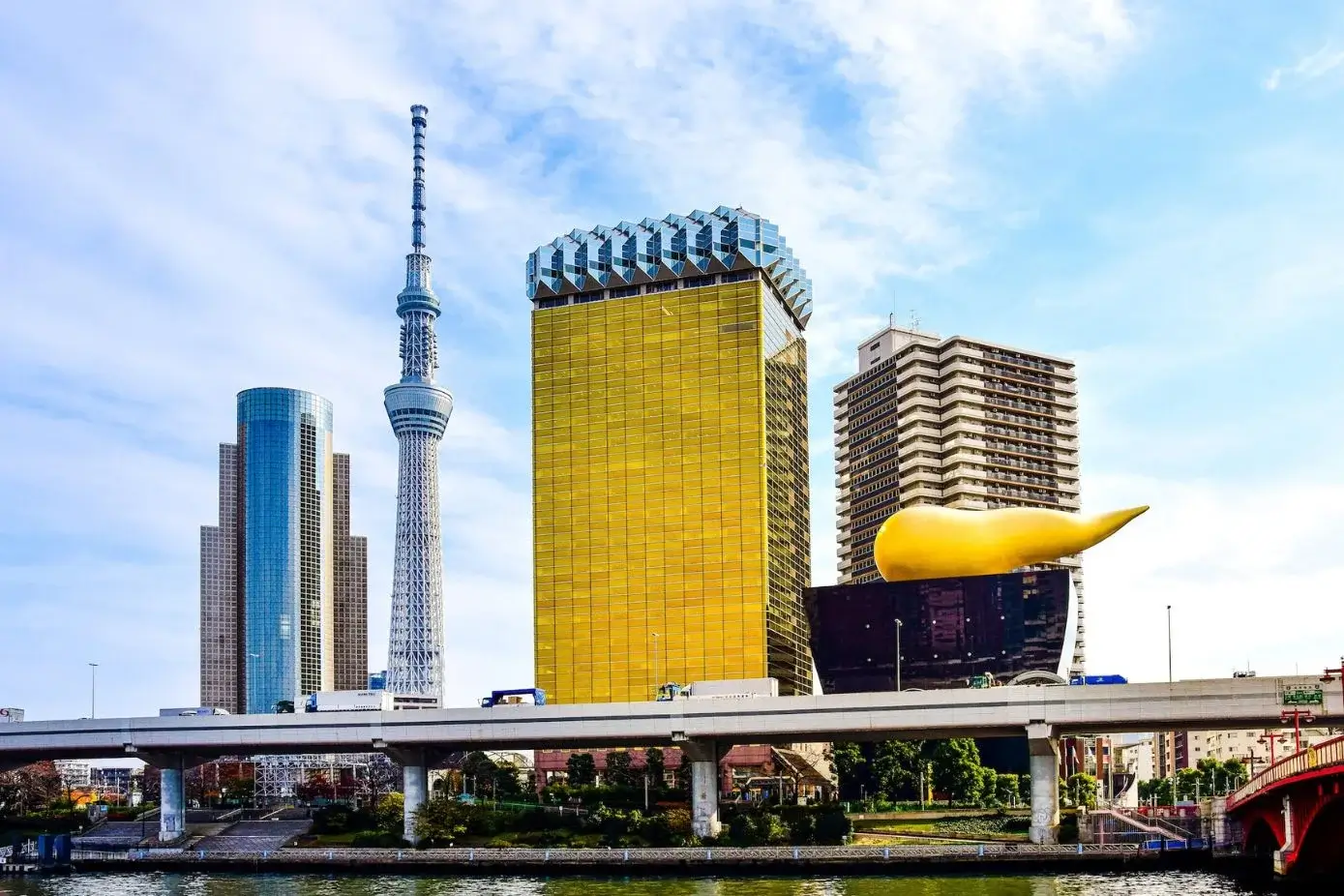
Soaring above the cityscape, the Tokyo Skytree dominates Tokyo’s skyline with an imposing elegance.
As you approach, its futuristic design beckons, promising unparalleled views of the sprawling metropolis below.
Once inside and ascending swiftly to its observation deck, the city unfurls beneath you. The panorama from this vantage point is breathtaking, revealing a vast urban tapestry that stretches to the horizon.
On clear days, the silhouette of Mount Fuji punctuates the skyline, adding to the awe-inspired experience. But the Skytree is more than just an observatory.
Descending to its base, a hub of activity awaits. From shops selling eclectic souvenirs to restaurants serving delectable cuisines, there’s something for everyone.
Asakusa Culture and Tourist Information Center

Situated at the heart of Asakusa, the Culture and Tourist Information Center serves as more than just a beacon for guidance.
As you enter, the helpful staff eagerly assist with maps and recommendations, ensuring you make the most of your Asakusa visit.
Climbing up to the center’s observatory deck, however, unveils another layer of its charm.
With sweeping views, you can gaze over Nakamise Street’s bustling activity, spot the iconic Senso-ji Temple, and witness the towering silhouette of Tokyo Skytree in the distance.
Rickshaw Ride
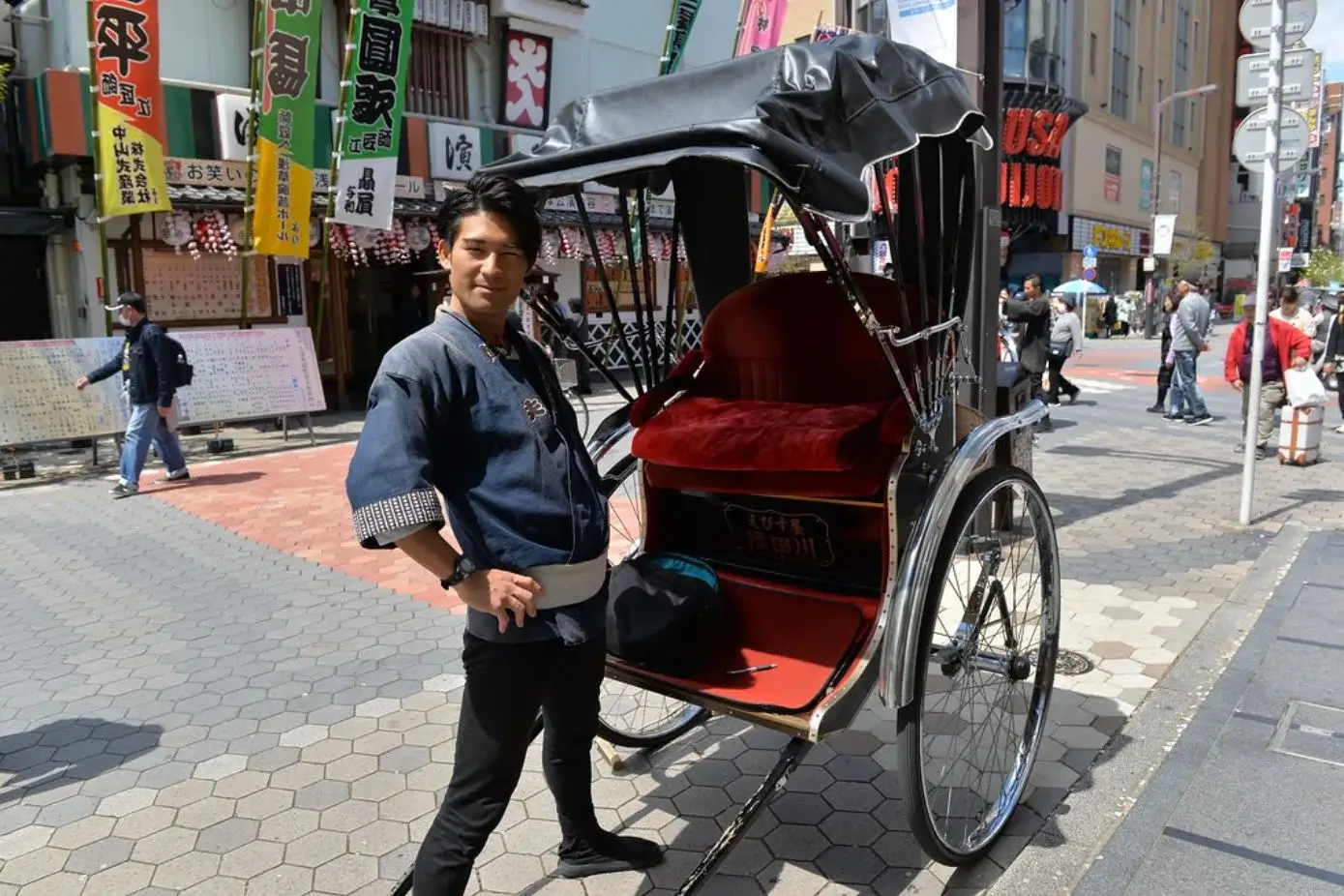
Stepping away from the modern hustle, the traditional rickshaw rides of Asakusa offer a charming journey back in time.
As you settle into the comfortable seat, skilled pullers share captivating tales of the neighborhood’s history, adding depth to the scenic views that pass by.
Navigating through narrow lanes and iconic landmarks, the ride captures the essence of old-world Tokyo.
Each turn reveals a blend of historic temples, bustling markets, and picturesque streets, offering a unique perspective only a rickshaw ride can provide.
Hanayashiki Amusement Park
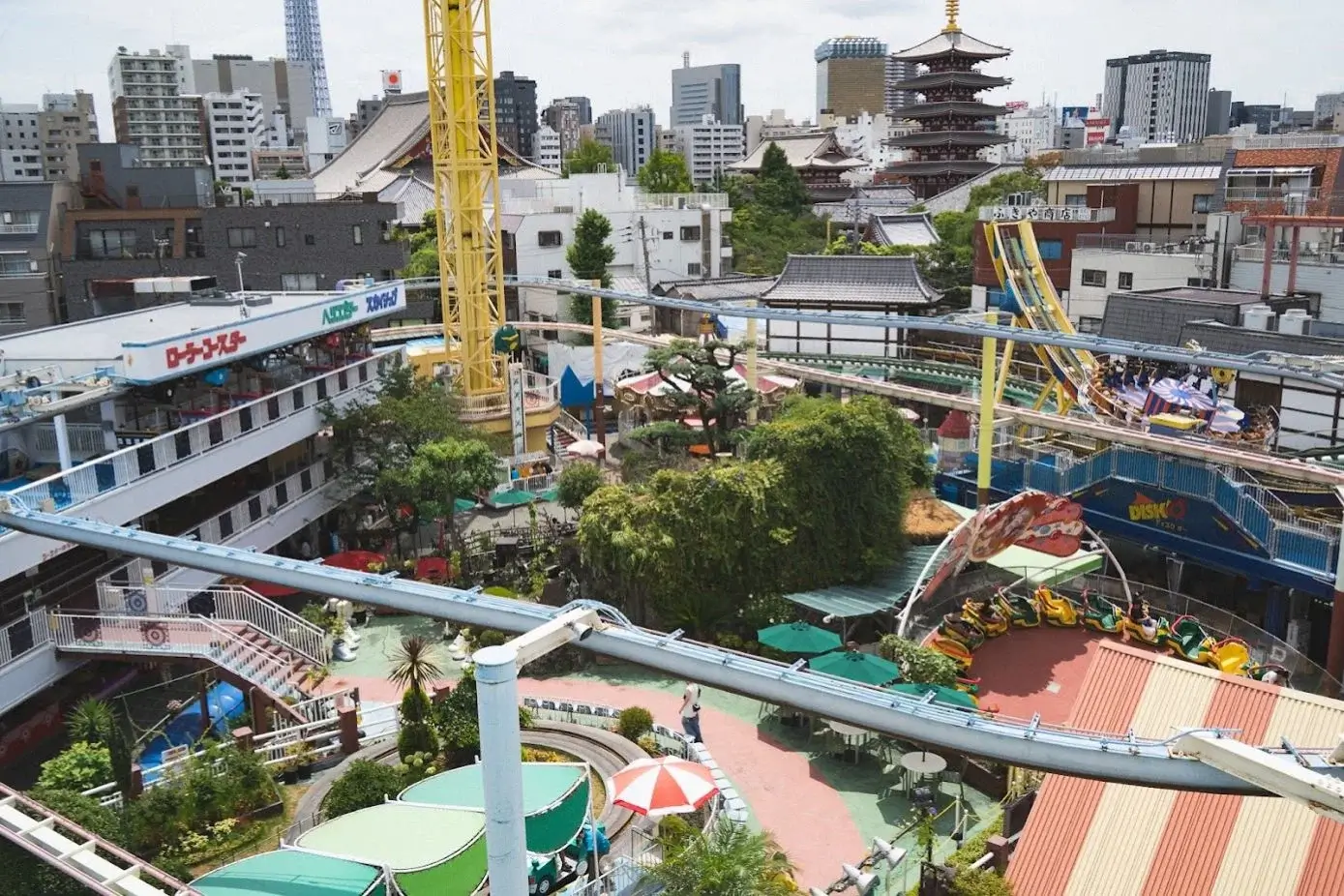
Just when you think Asakusa’s charms are rooted solely in history, Hanayashiki Amusement Park bursts onto the scene with its nostalgic allure.
Holding the title of Japan’s oldest amusement park, it instantly transports visitors to a bygone era.
While its rides may not rival modern thrill-seekers’ towering coasters, each attraction brims with a unique charm and simplicity.
From the vintage carousel to the petite roller coaster, every turn offers a delightful surprise.
Additionally, the park’s quaint atmosphere provides a serene contrast to Tokyo’s usual high-paced energy.
Official website: https://en.hanayashiki.net/
Kappabashi Kitchen Street
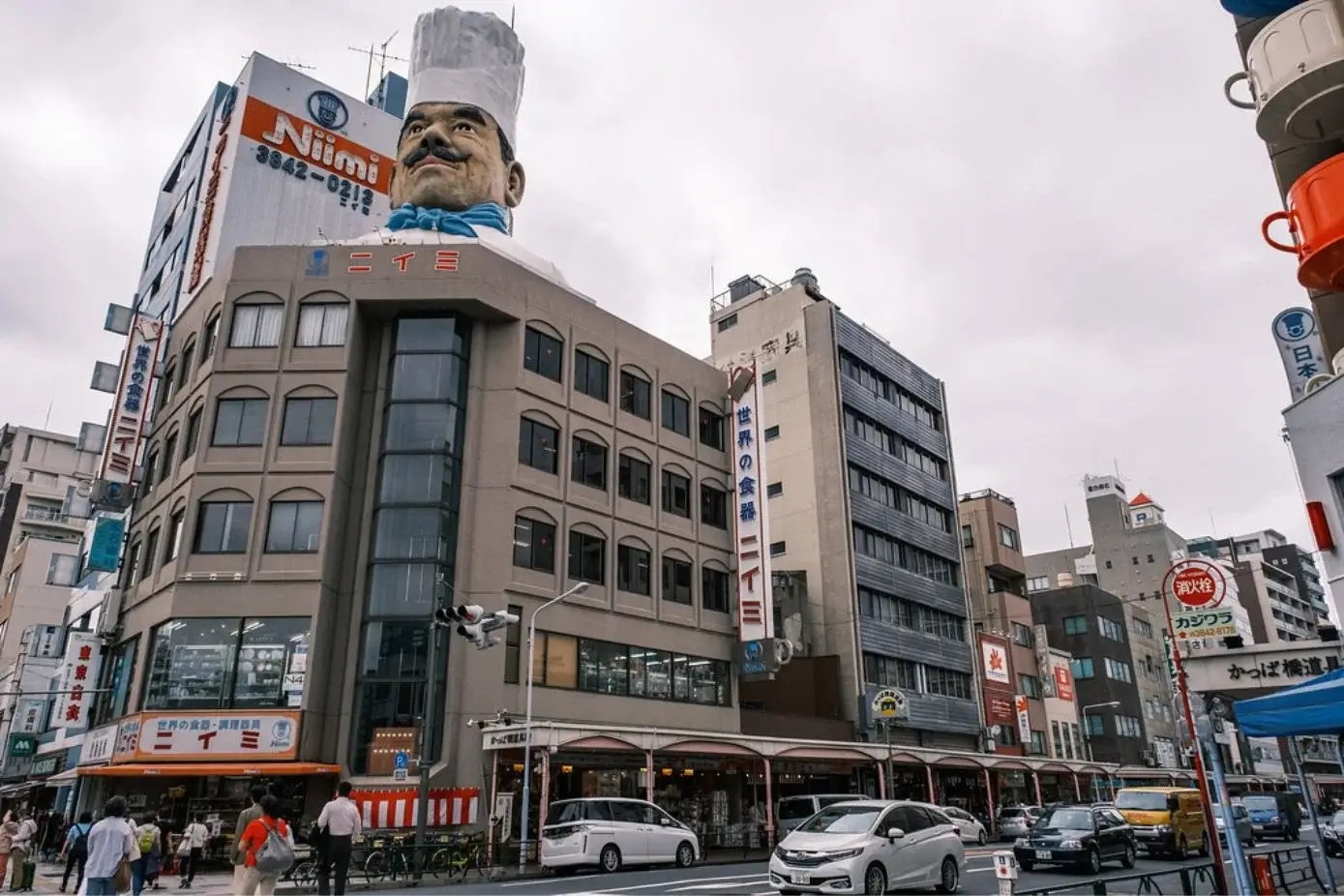
Diving into Asakusa’s more niche attractions, Kappabashi Kitchen Street emerges as a paradise for culinary enthusiasts.
As you walk this specialized boulevard, stores display everything from gleaming chef’s knives to intricately detailed plastic food models.
With each step, the passion for craftsmanship becomes evident, showcasing tools and equipment that cater to both professional chefs and home cooks.
But it’s not just about purchasing; the sheer spectacle of lifelike plastic foods, often used by restaurants for display, offers a visual treat.
Asakusa Engei Hall
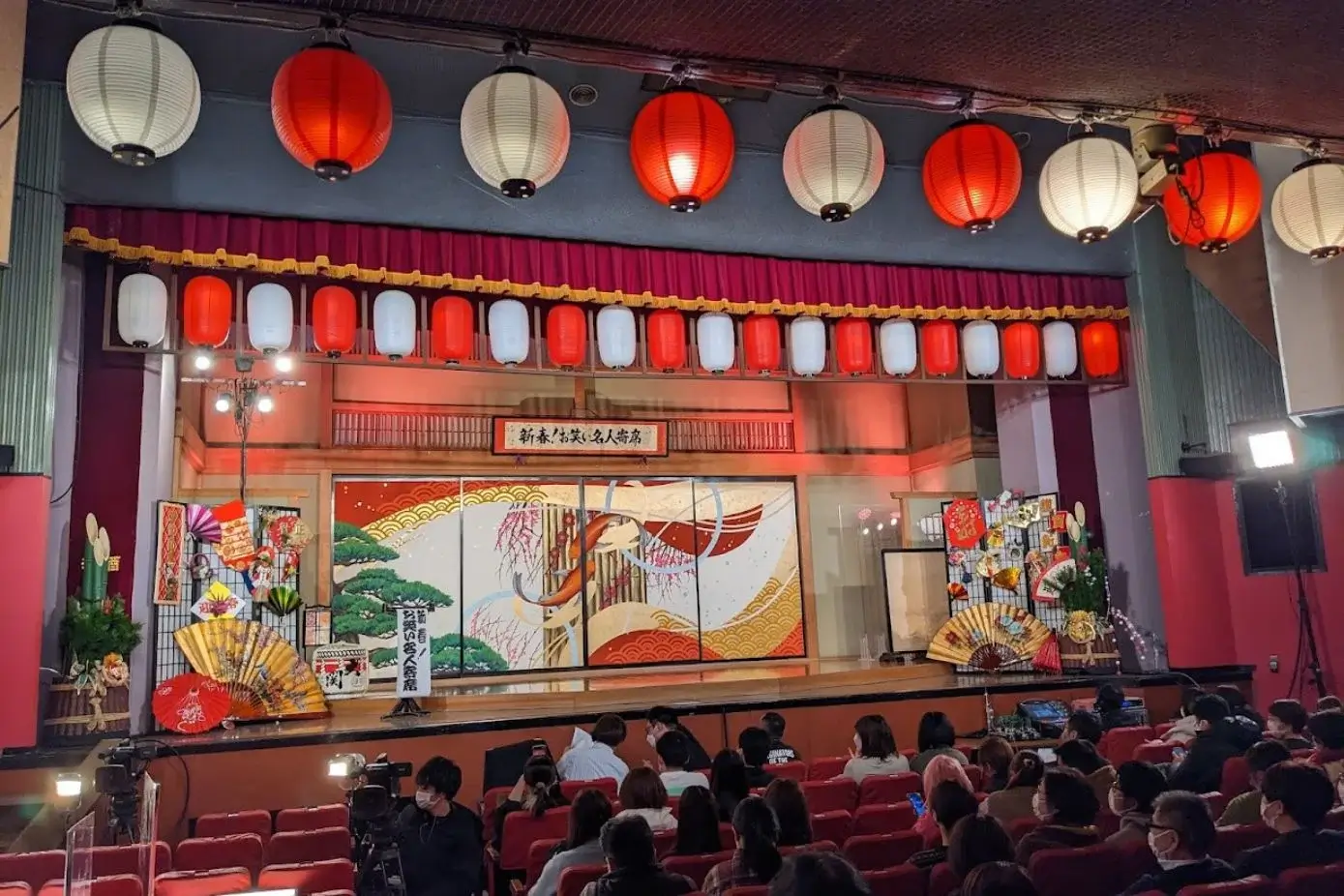
Venturing into the realm of traditional entertainment, Asakusa Engei Hall stands out as a hub of classic Japanese performances.
As you step inside, the ambiance transports you to an era where storytelling and stagecraft reign supreme.
The spotlight here often falls on “rakugo”, a comedic storytelling art form, with performers bringing tales to life using just their voices and minimal props.
Between acts, vaudeville performances offer a delightful mix of music, magic, and jest.
Every show, whether evoking laughter or awe, encapsulates the spirit of traditional entertainment.
Sumida Aquarium

Delving into the aquatic wonders of Tokyo, the Sumida Aquarium emerges as a serene oasis amidst Asakusa’s urban landscape.
As you step through its doors, a myriad of marine life awaits, swimming gracefully in meticulously designed habitats.
The innovative, open-tank layouts immerse you in an underwater world, where you can observe everything from vibrant coral reefs to the mesmerizing dance of jellyfish.
Transitioning between sections, the aquarium artfully represents various aquatic ecosystems, ensuring each visit is both educational and enchanting.
Moreover, its commitment to conservation and sustainable practices shines through, adding depth to the experience.
Official website: https://www.sumida-aquarium.com/index.html
Hoppy Street
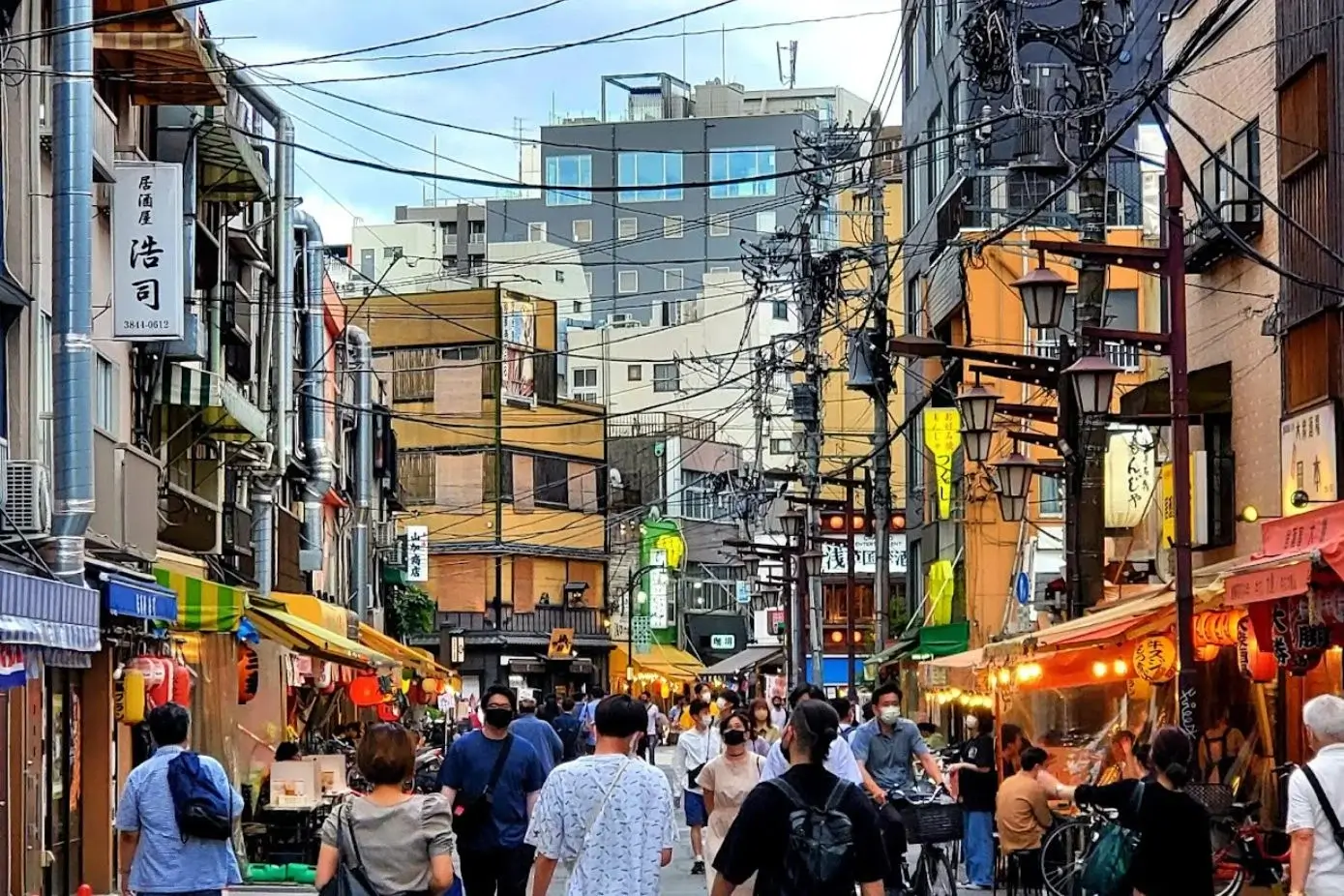
Stepping into the lively alleys of Asakusa, Hoppy Street emerges as a lively stretch of festivity and camaraderie.
Named after the popular non-alcoholic drink that resembles beer, the street pulsates with energy, especially as evening descends.
As you wander along, inviting izakayas (Japanese taverns) beckon with the tempting aroma of grilled delicacies and the clink of glasses.
Here, both locals and tourists converge, toasting good times and sharing plates of sumptuous food.
Transitioning from one tavern to the next, every encounter offers a new flavor, story, or laughter.
To enjoy your gastronomic experience at its fullest, make sure to check our guide on how to eat with chopsticks, as it’s the main way to eat in Japan.
Taste Ningyo-yaki
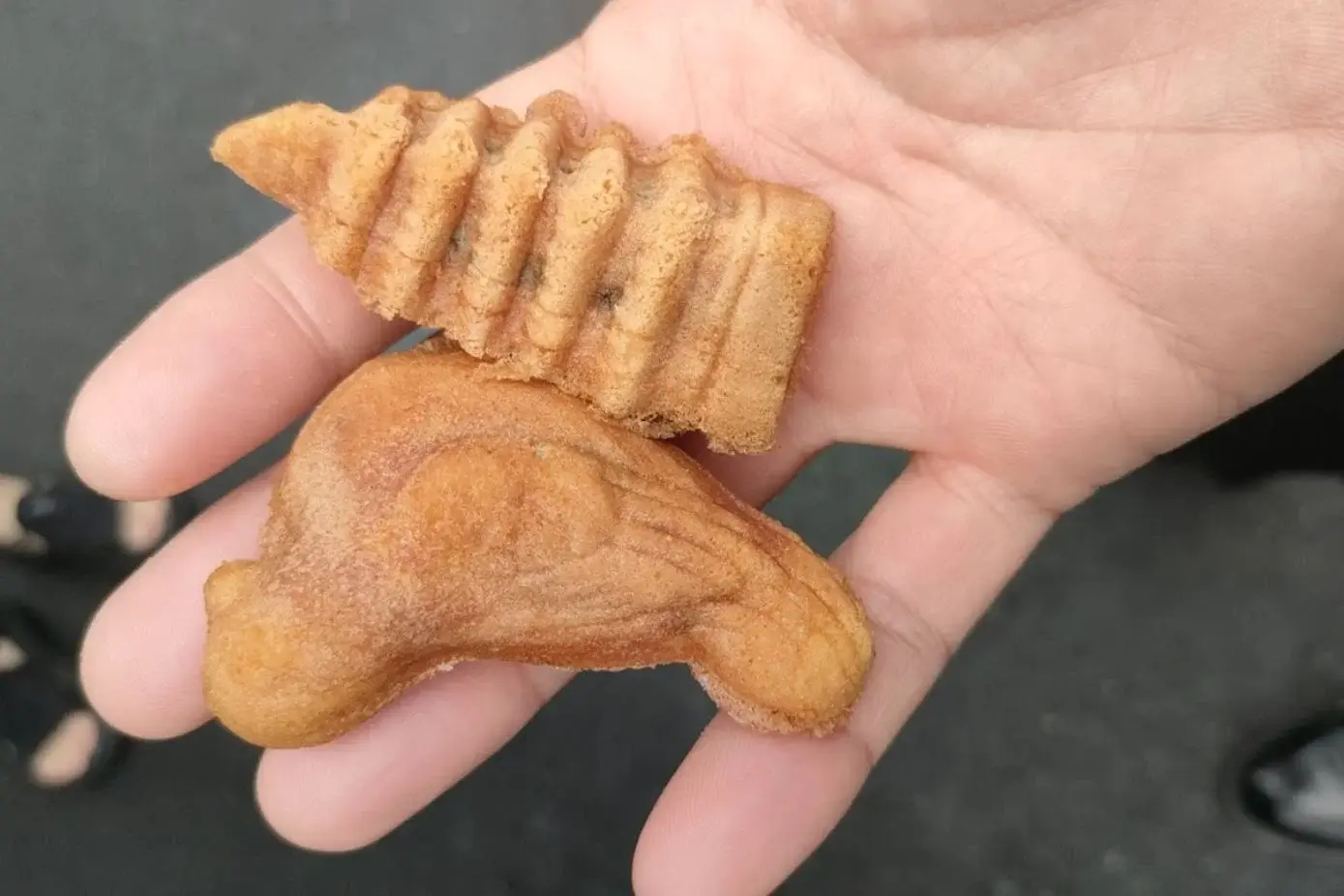
Delving into the flavors of Asakusa, the delightful taste of Ningyo-yaki stands out as a must-try treat.
As you wander the streets, quaint shops with sweet aromas draw you in, revealing artisans crafting these iconic doll-shaped cakes.
Watching the batter poured into intricate molds and skillfully baked is a treat in itself.
But the true joy comes as you take your first bite, with the fluffy sponge cake giving way to a rich red bean filling.
Each nibble not only offers a burst of flavor but also a taste of Asakusa’s culinary heritage.
Azumabashi Bridge
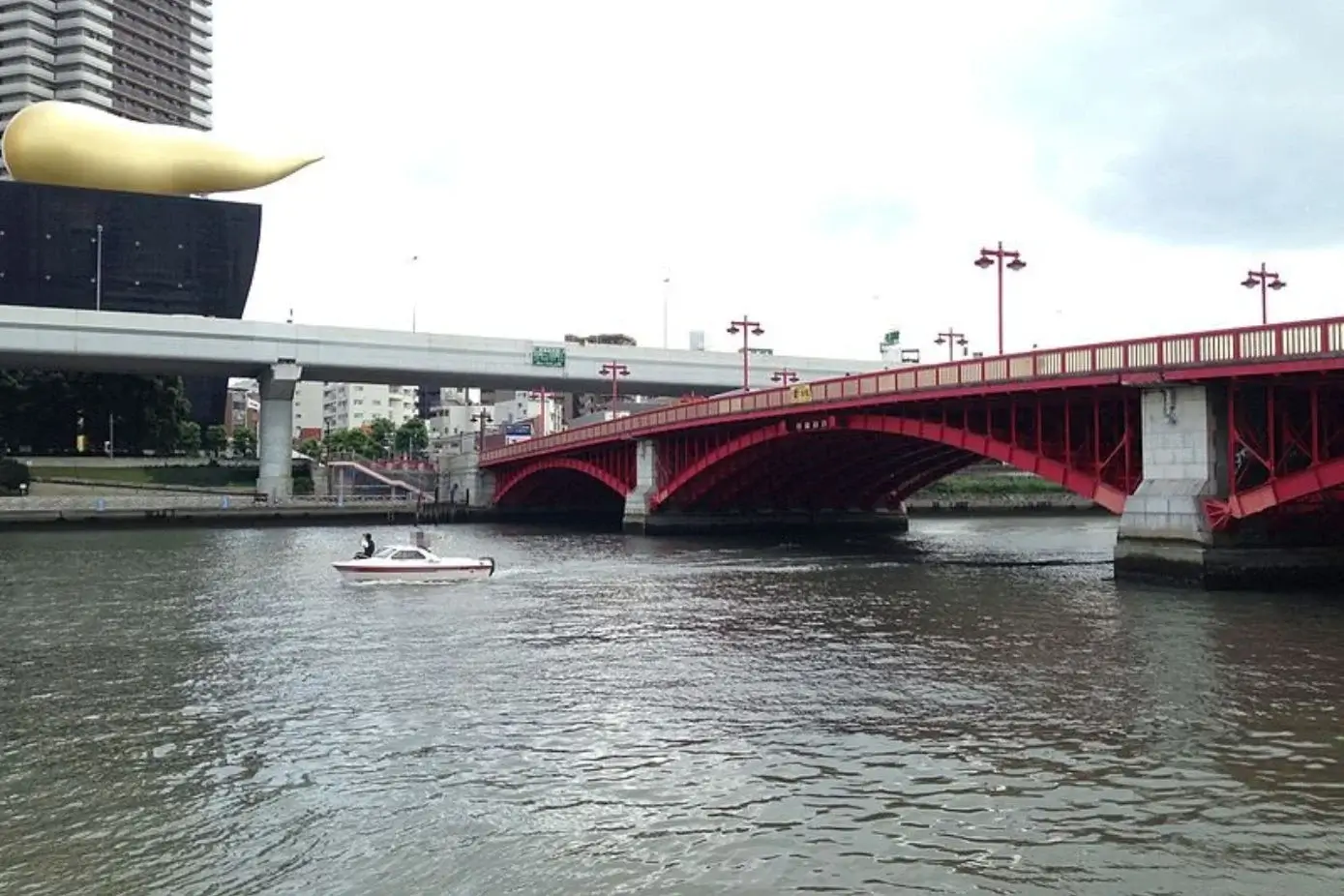
Shifting your gaze towards Asakusa’s scenic waterways, the Azumabashi Bridge elegantly spans the Sumida River.
As you approach, its red steel structure contrasts beautifully with the serene blue waters below.
Walking across, each step offers panoramic views of Tokyo’s skyline, including the towering majesty of the Tokyo Skytree in the distance. But it’s not just about the sights.
The bridge itself stands as a testament to the area’s history, connecting two vibrant neighborhoods and serving as a symbolic gateway.
Pausing midway and feeling the gentle river breeze, the Azumabashi Bridge offers a tranquil respite amidst urban exploration, effortlessly blending architectural beauty with nature’s tranquility.
Sanja Matsuri
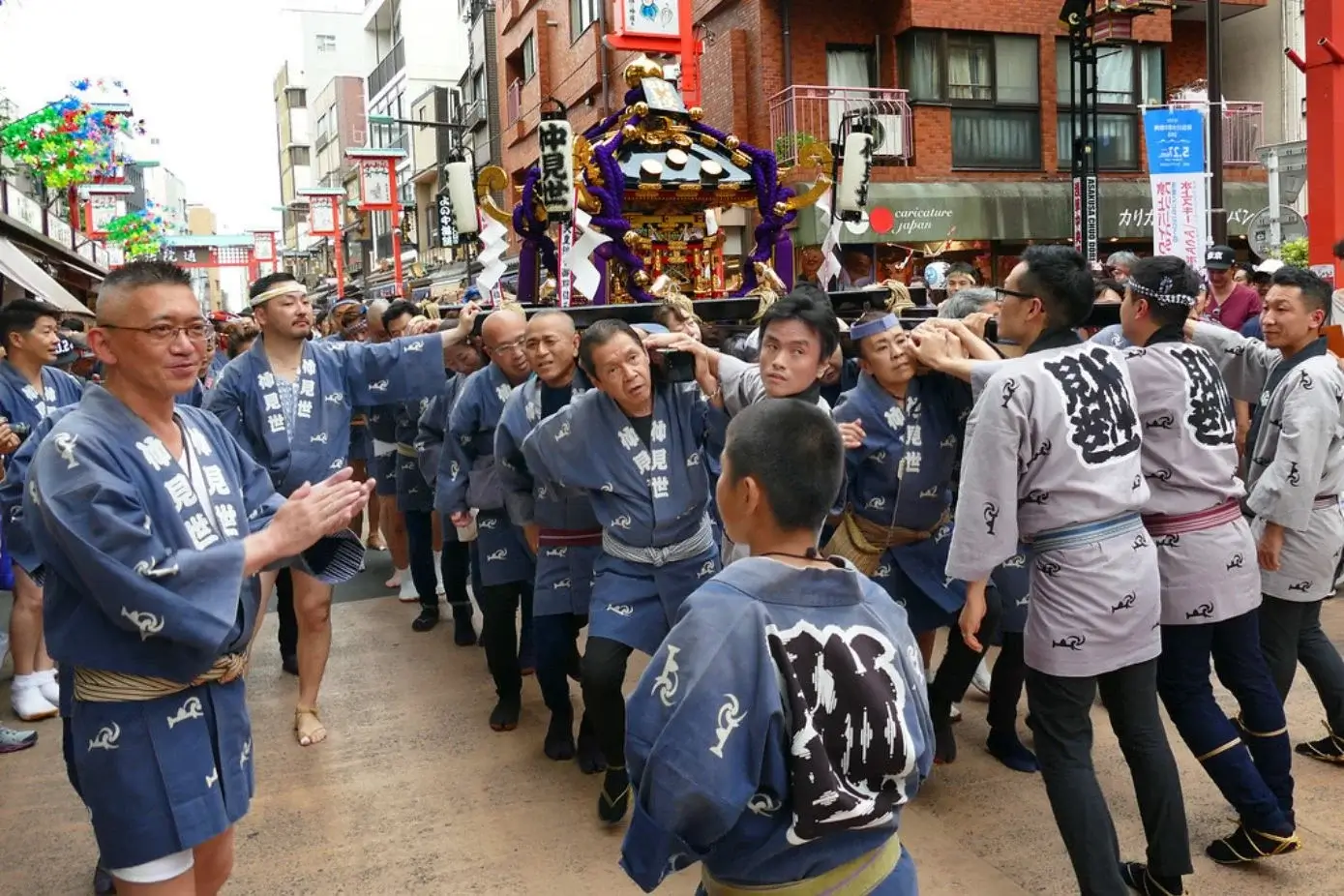
Diving deep into Asakusa’s cultural heartbeat, the Sanja Matsuri emerges as a spectacular celebration of faith, spirit, and community.
Held annually, this vibrant festival transforms Asakusa’s streets into a tapestry of color, music, and energy.
As you join the throngs of spectators, ornate mikoshi (portable shrines) dance through the streets, carried by enthusiastic locals who chant and sing in unison.
Each shrine represents a neighborhood, and the lively procession showcases their collective pride and devotion.
Transitioning through the festival grounds, various performances, from traditional dances to rhythmic drumming, captivate and entertain.
Edo Shitamachi Traditional Crafts Museum
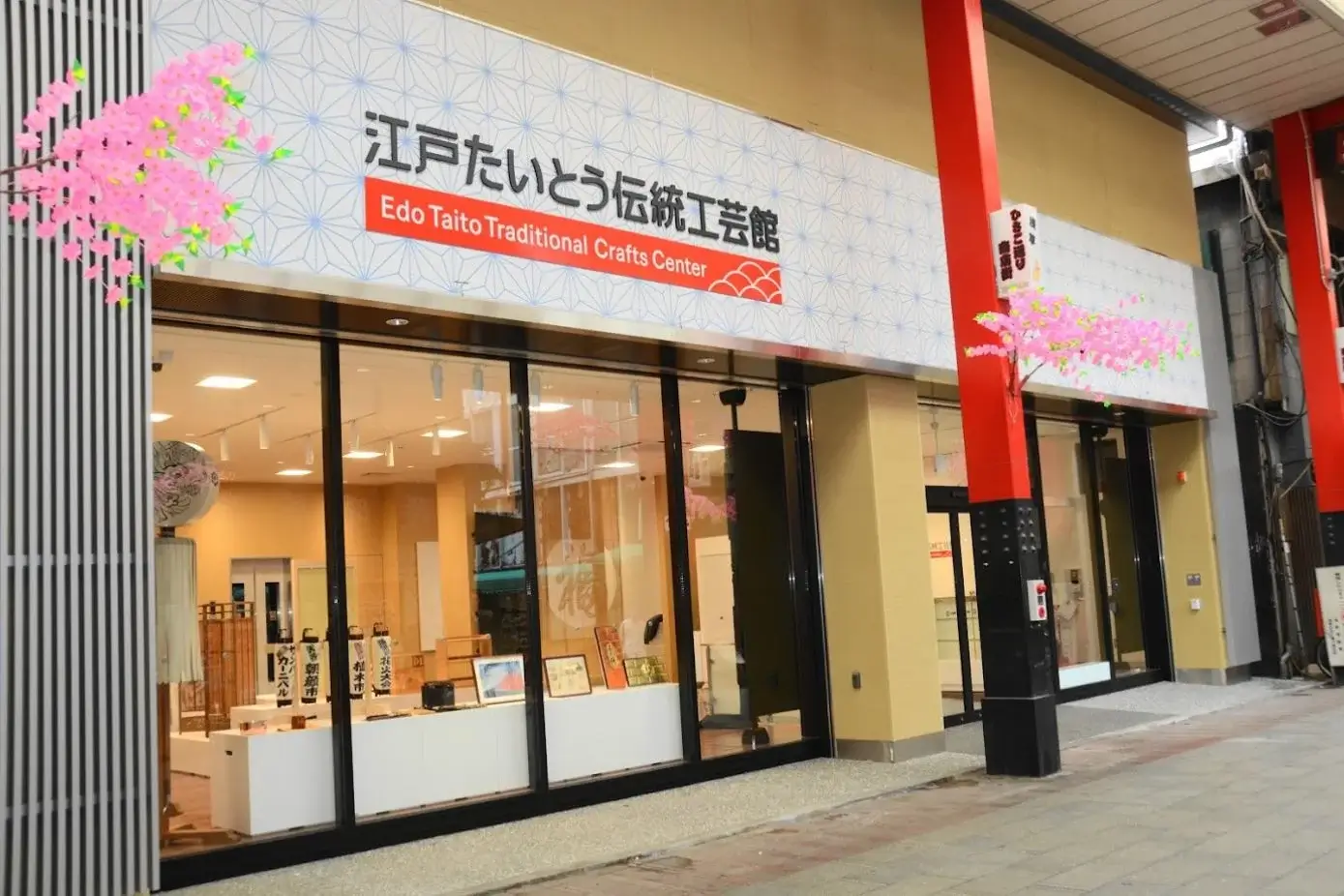
Venturing into the intricate world of craftsmanship, the Edo Shitamachi Traditional Crafts Museum unveils a panorama of Tokyo’s artisanal heritage.
As you step inside, the museum’s curated displays transport you to the Edo period, an era when meticulous handiwork defined every product.
Moving from one exhibit to the next, the museum showcases diverse crafts, from intricate woodwork to delicate textiles.
With every artifact, the dedication and precision of ancient artisans come alive, revealing stories woven into each thread and carved into every piece.
Moreover, live demonstrations by skilled craftsmen add a dynamic layer to the experience, bridging past traditions with present skills.
Asakusa Public Hall

Stepping into the realm of performing arts, the Asakusa Public Hall emerges as a cultural epicenter in the heart of the district.
As you approach, the building’s classic architecture hints at the traditional performances held within its walls.
Upon entering, the grandeur of the auditorium, adorned with ornate details, takes center stage.
Throughout the year, the hall resonates with the sounds of kabuki theater, traditional concerts, and various other performances, each narrating tales of Japan’s rich heritage.
Navigating the calendar, special events often grace the stage, providing locals and tourists alike a chance to experience Japanese arts in their most authentic form.
Sumida Park
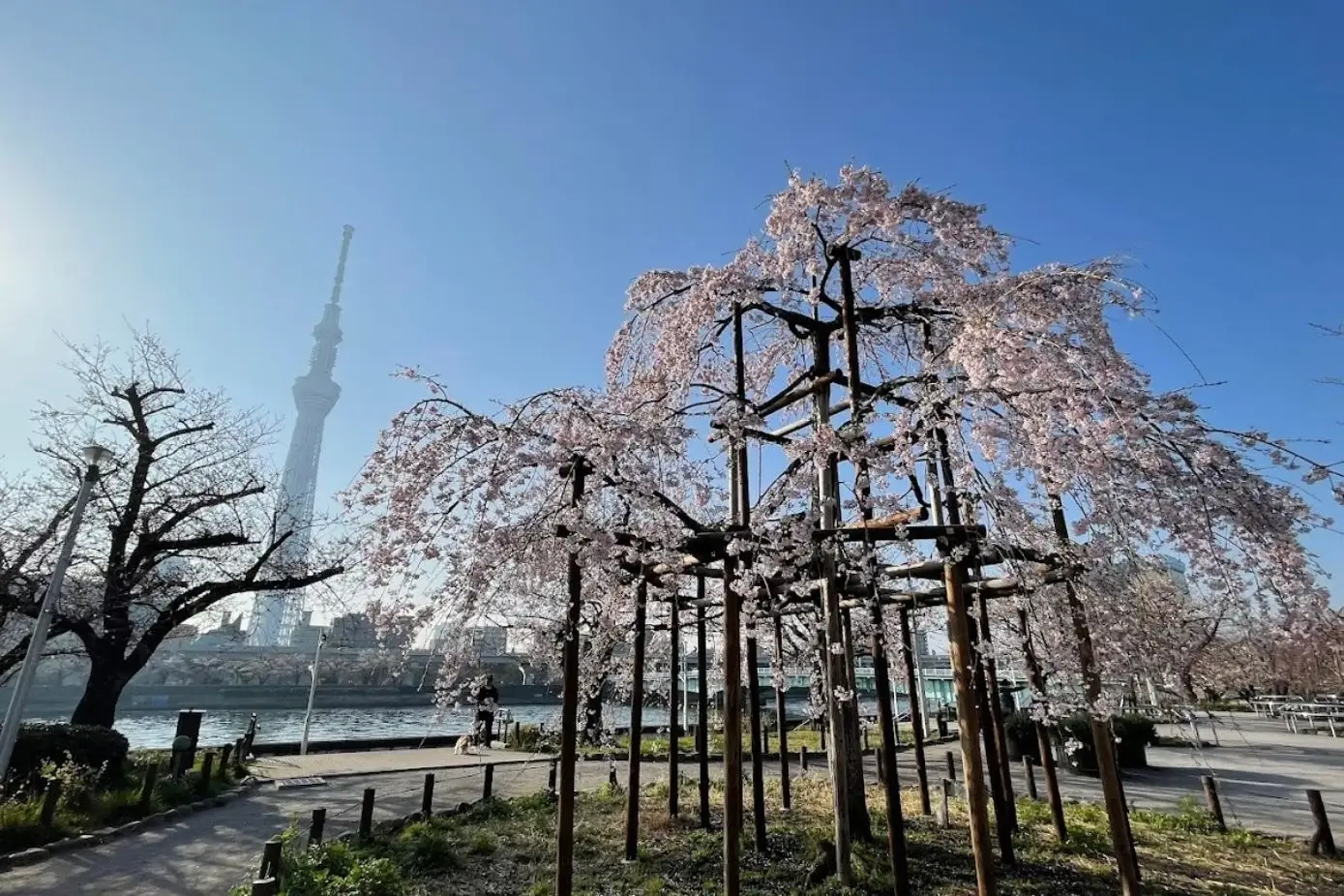
Venturing just a short distance from the bustling streets of Asakusa, Sumida Park welcomes visitors with its lush expanse and tranquil ambiance.
As you step onto its pathways, a canopy of trees offers shade and serenity, making it an ideal respite for weary travelers.
Meandering along the Sumida River, the park presents picturesque views, with Tokyo Skytree standing tall in the backdrop.
Depending on the season, nature offers its own spectacle: cherry blossoms paint the landscape in spring, while autumn drapes the park in a warm, golden hue.
Beyond its natural beauty, the park frequently hosts local events, festivals, and performances, infusing it with community spirit.
More info ➜ The 8 Best Japanese Gardens in Tokyo
Demboin Garden
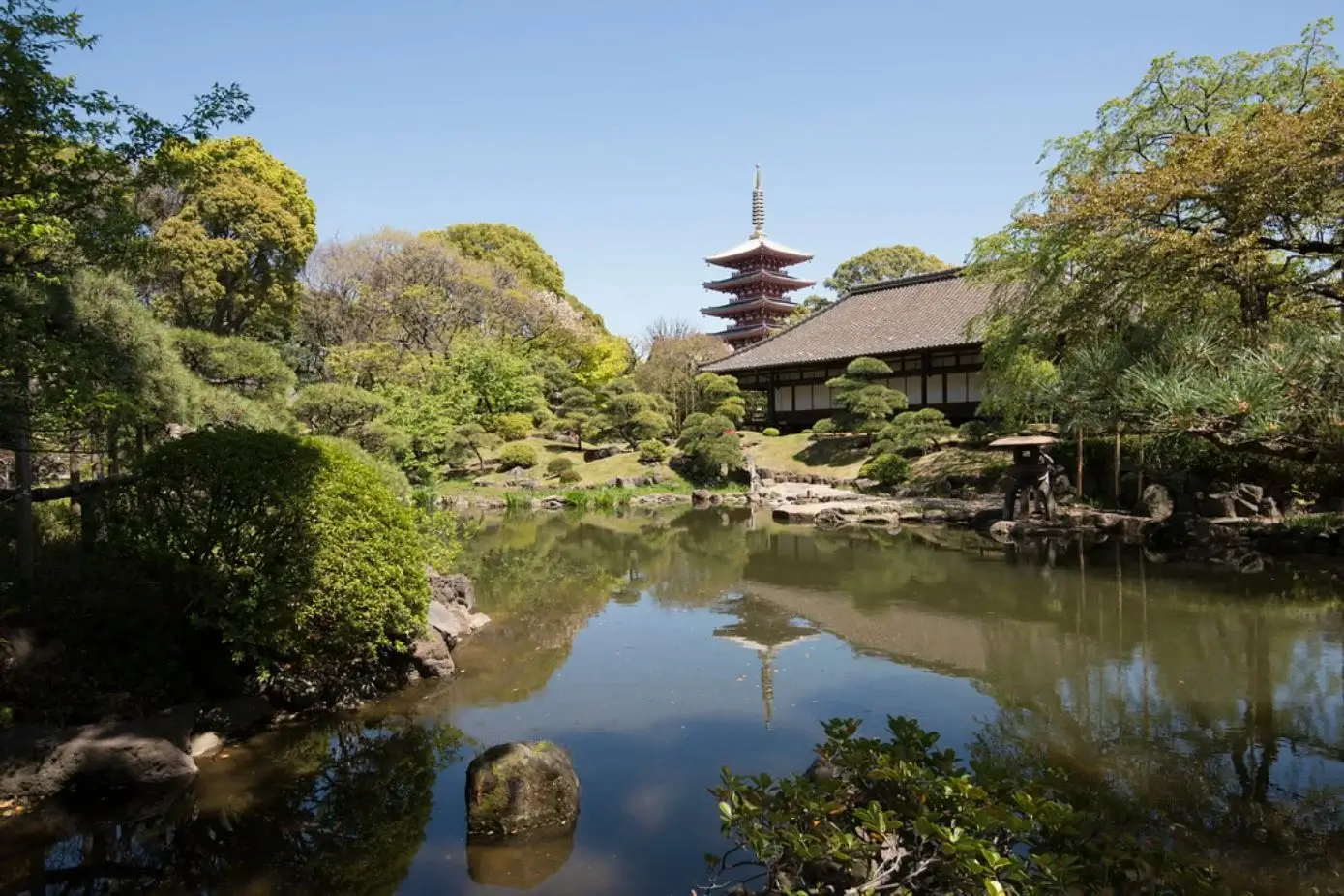
Nestled within the vibrant precincts of Asakusa, the Demboin Garden stands as a hidden gem of tranquility and aesthetic beauty.
As you enter its grounds, the meticulously manicured landscape captivates the senses, echoing the principles of traditional Japanese garden design.
Winding pathways beckon visitors to explore, leading them past serene ponds, elegant stone arrangements, and ancient trees.
Each turn reveals a carefully curated view, designed to inspire reflection and appreciation.
Often, the melodic chirping of birds accompanies the soft rustling of leaves, enhancing the garden’s meditative ambiance.
Moreover, seasonal shifts bestow unique charms upon the garden, from cherry blossoms in spring to vibrant red maples in autumn.
Try Traditional Sweets at Funabashiya
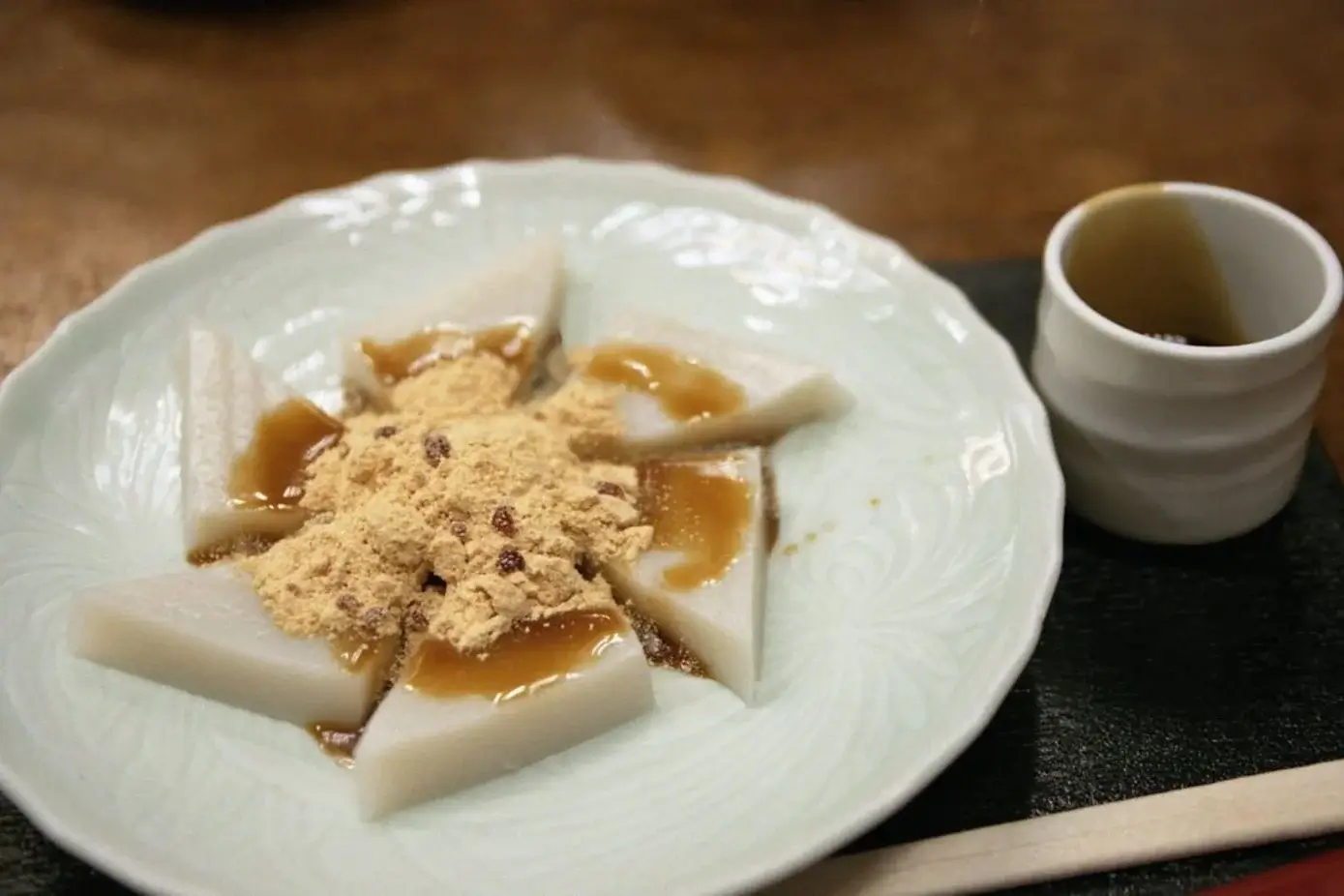
Diving into the sweet side of Asakusa, a visit to Funabashiya introduces taste buds to a delightful symphony of traditional flavors.
As you approach this iconic establishment, its storied history, spanning over two centuries, adds weight to every bite you’re about to savor.
Stepping inside, the aroma of freshly made confections wafts through the air, promising indulgence.
The star of the show is ‘kuzumochi’, a gelatinous treat steeped in sweet syrup, whose delicate texture and refined taste exemplify Japanese dessert craftsmanship.
Paired with a cup of green tea, each bite becomes an experience, balancing sweetness with subtlety. Beyond just flavors, Funabashiya offers insight into Japan’s rich culinary legacy.
Rokku Entertainment District

Venturing into the heartbeat of Asakusa’s nightlife, the Rokku Entertainment District pulsates with a blend of historic allure and contemporary buzz.
As you step onto its bustling streets, the echoes of the district’s past as Tokyo’s premier pre-war entertainment hub subtly blend with the present.
Neon lights beckon visitors to explore theaters, jazz bars, and modern entertainment venues.
Each corner unravels stories of a time when Rokku was the epitome of Tokyo’s entertainment scene, hosting cinemas, playhouses, and vaudeville theaters.
Transitioning from one venue to the next, performances ranging from traditional Japanese arts to contemporary shows captivate the senses.
Final Thoughts
As we retrace our steps through the vibrant streets of Asakusa, it becomes undeniably clear that this district is more than just a travel destination.
It’s a living tapestry of history, culture, and modern-day Tokyo. Wandering through ancient temples, pausing at bustling shopping streets, and indulging in traditional sweets, each experience not only entertains but also educates, connecting visitors with the very soul of Japan.
Reflecting upon this journey, Asakusa emerges not merely as a checklist of attractions but as a narrative of stories, traditions, and encounters.
In essence, every corner, every taste, and every sound in Asakusa invites travelers to immerse, engage, and remember.
If you are wondering what to do in Tokyo, check this article below!
Are you also looking for the things to do in the areas near Asakusa?
- Top Things to Do in Akihabara
- Best Things to Do in Shinjuku
- Best Things to Do in Harajuku
- Best Things to Do in Shibuya
- Best Things to Do in Ueno
- Best Things to Do in Ikebukuro
FAQ
Asakusa is primarily known for the historic Senso-ji Temple, Tokyo’s oldest temple, and the surrounding Nakamise Shopping Street. However, it also boasts a mix of traditional and modern attractions.
Asakusa is easily accessible by Tokyo Metro Ginza Line, Toei Asakusa Line, and Tobu Skytree Line. The Asakusa Station serves as the main transportation hub for the area.
Definitely! Attractions like the Hanayashiki Amusement Park and Sumida Aquarium cater specifically to families and children.
While Asakusa is lovely throughout the year, spring (for cherry blossoms) and autumn (for colorful foliage) offer particularly picturesque views, especially in spots like Sumida Park and Demboin Garden.

